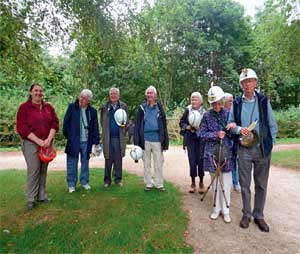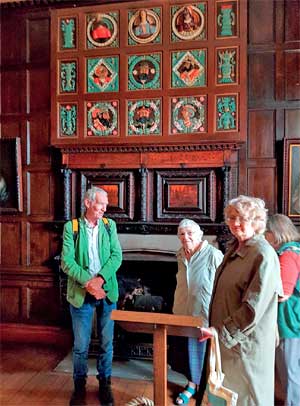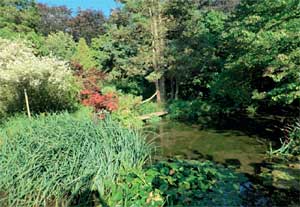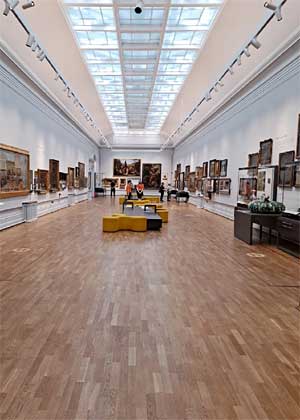Events and excursions, Autumn 2021
24th August 2021: Visit to Creswell Crags
 Members at Creswell Crags.
Members at Creswell Crags.At last, after several weeks of uncertainty about whether any visits would be allowed depending on the Covid-19 restrictions a group of 17 Thoroton members visited Creswell Crags on 24th August 2021 after taking last minute Covid-19 lateral flow tests. Creswell Crags, lying on the border of Nottinghamshire and Derbyshire, is a limestone gorge famous for its caves and the only cave art in Britain known at present. It is a SSSI for geology and holds Scheduled Ancient Monument Status. It is also on the UNESCO shortlist for World Heritage Status. Members gathered at the entrance to Creswell Crags to be greeted by the Education team and taken to the Education Room which had been reserved for our exclusive use during the visit complete with tea, coffee and soft drinks. The visit started with an illustrated talk by Jen, the Learning Officer which was very interesting and erudite. Jen explained the geology of the region and how the variation in climate over millennia had affected the fauna and flora, from the semi-tropical of 120,000 years ago when hippopotami enjoyed the water and lush vegetation, to 70.000 years ago when extreme cold was not compatible with life, to 40,000 years ago for a brief period of Neandertal presence until abandoned 22,000 years ago at the glacial maximum, then up to 12,000 to 13,000 years ago when human presence resumed in a tundra-like environment with hyenas and mammoths. The humans were Homo sapiens - just like modern humans but possibly with darker skin like Cheddar Man who was found by a DNA analysis to have the genes for dark skin and blue eyes. Evidence came from excavation although the early excavations from the 1870s onwards lacked modern precision with no published reports and collections of finds having disappeared.
The excavators discarded material that now would be assessed so it is possible that in the spoil heaps that early diggers piled up at the cave entrances, there are treasures awaiting future archaeologists. The landowners used the area as a leisure facility, the Robin Hood cave had been used as a boathouse and the river dammed to provide a boating lake for example.The talk concluded with a demonstration of reconstructed clothing, modelled by one of the Education Team, that has been suggested was worn when the caves were inhabited by semi-nomadic hunter-gatherers of the late Pleistocene. Evidence came from Creswell Crags and other similar sites of pierced stones that may have been used for decoration and bone needles indicating that sewing was used. The costume was reminiscent of the traditional clothing made from reindeer leather worn by the Sami people. During the talk, members were able to handle some artefacts (or reproductions) including worked flints, an atl-atl and the inevitable mystery object which may have been a spear straightener. After the talk and questions, the pre-ordered lunches were brought to us. Members had some free time to wander round or visit the museum before dividing into groups to visit the Robin Hood Cave. Groups were small to keep to social distancing guidelines. Members were issued with hard hats and lights and sallied forth into the dark. The cave guides explained the geology, what had been found, the remnants of the Victorian excavators and their attempts to “improve” the caves by levelling the floor. We were shown graffiti in the form of witchmarks added from the 17th century onwards to ward off demons and evil spirits. Clearly, if more excavation was allowed, answers to questions about our early neighbours could be possible. This excursion has differed in format from previous years: that we are still in the midst of a pandemic made arrangements uncertain until the last minute. The decision to ask members to travel under their own steam was a wise precaution and avoided any risk that might have occurred from gathering in a coach. The Creswell Crags visitor team were very adaptable and made our visit run as smoothly as possible. Visiting caves would normally have meant that visitors and staff were in close proximity. The guides and Jen were extremely knowledgeable, inserting humour as appropriate and made the visit interesting. The Creswell Crags staff are to be congratulated about how they are managing visits in a safe manner at this difficult time.
Wednesday 22nd September: Newstead Abbey and gardens
Leaders: Pete Smith and Philip Jones
 Pete Smith, Penny Messenger and Margaret Trueman at Newstead Abbey.
Pete Smith, Penny Messenger and Margaret Trueman at Newstead Abbey.
The Japanese Garden at Newstead Abbey.
We were favoured with a beautiful autumn day when a small but very select group met with Pete Smith outside the main entrance to Newstead Abbey. Pete began, facing the Abbey front, by explaining which parts were original and for what purpose they were used, and when later additions were made. As we progressed round the inside of the building some idea emerged of the detective work that has been necessary to piece together which parts were built or altered when and by whom. There was far too much information given to summarise, all of it fascinating, much of which is presented in Newstead Abbey, A Nottinghamshire Country House: Its owners and architectural history 1540-1931, (2014), by Rosalys Coope and Pete Smith.
But, of the many items which could be singled out, it is worth saying that the several wonderful painted overmantels were even more striking in real life than in the book illustrations, as were the beautiful eighteenth-century white marble fireplaces. Two nuggets of information are worth a mention. Some painters employed specialist lace painters to whom they left the completion of the lace details, the named artist having done the main parts of a portrait. After the French Revolution, Sevres had a huge excess of china plates which had been manufactured, but most of their usual customers had been executed. So they marketed them unpainted for people to finish, and Maria Wildman (sister of Colonel Wildman of the Abbey) painted scenes on several of them - rather skilfully as well.
After a swift lunch at the cafe, Philip Jones joined us for a tour of the gardens. Again, an enormous amount of interesting and sometimes esoteric information. For example, the special Watsonian Patent Fern Bricks, patented in 1860 and manufactured in the early 1870s, were made specially to allow ferns to be planted in a wall, in a little dish that would fit into them. Newstead is the only site known to have 15 of them in good condition set in a wall in the Fern Garden which was laid out in 1874. Philip has seen to it that they and the wall they are set in have been Grade II listed.
There is also a Victorian grotto, which is unusual enough to be a Grade 11 listed. Most Japanese gardens were started around 1910 after an influential exhibition, but Newstead has one that was laid out in 1899 by Ethel Webb, of the Webb family who were then the owners of the Abbey. As Philip has noted in last year's Autumn newsletter (Autumn 2020, issue 101), Ethel was also responsible for the Japanese room in the house. In 2022 there is to be a Japanese Exhibition at Newstead, which will include paintings and drawings on loan from Kew. It was a wonderful day with two of the most expert guides, and the Japanese Exhibition next year must be an excuse for another Thoroton excursion, surely!
Rosemary Muge
Wednesday 8th September 2021 Members Visit to Nottingham Castle
 Art Gallery at Nottingham Castle
Art Gallery at Nottingham Castle The visit to Nottingham Castle had been very well managed by Ruth Strong and all who attended were able to enjoy a fascinating discovery of how the castle had been transformed. I am sure that all left having enjoyed the visit. Our first tour was of various Galleries and from magnificent medieval alabaster figures such as those shown on the front cover, to the magnificent Art Gallery our guide was able to pass on a good deal of valuable historical knowledge. The medieval alabasters were stunning. Our guide explained how artworks such as the alabaster figures, stained glass windows, paintings and sculptures helped to spread Christian beliefs to many people who were unable to read or write in medieval times and how the parish church was central to everyday life. She explained how Nottingham was an important centre for alabaster carvers in the 14th and 15th centuries and how the alabaster was available in the Chellaston Hills of Derbyshire and easily transportable to Nottingham. Evidence has been found in Nottingham of workshops and disposal pits which are associated with alabaster carvers. We also learnt how Nottingham potteries were owned by two families the Morleys and the Wyers and how the Morley’s apprentice Richard Wyer had opened the Boot Lane Pottery in the 18th century and how we knew dates through pottery being dated by these potteries. From this gallery we moved on to the Lace Gallery. The story of the growth of the Nottingham Lace Industry and the magnificent displays were appreciated and we now entered the Art Gallery which was the centerpiece of the former Midland Counties Art Museum. This was, I thought, inspirational with historic art works. Paintings of well known historic characters such as ‘Benjamin Mayo, The Old General’ and a painting of the Goose Fair by Arthur Spooner were among the paintings that caught my attention but many others in the Long Gallery were studied and admired. The whole idea of mixing together paintings, sculpture, drawings, ceramics, textiles and jewellery from different historical periods organised around themes worked for me. There was then time for members to have lunch in the Terrace Cafe before our visit down to a Cave. It was a pity that we were unable to see Mortimer's Cave but our well informed guide gave us tales about the intriguing caves. As Brewhouse Yard was closed we were unable to travel on the Land Train and see what is advertised as 1,000 years of history as you travel from Brewhouse yard to the Ducal Palace. Instead we had Robin Hood to look forward to. It is interesting how Thoroton members suddenly reverted to childhood as we watched the story of Robin Hood and played on the digital interactives in the Robin Hood Experience area. One of the real pluses for visitors are the very good information boards that allow all visitors to absorb the history of the castle and the people who were part of its history. In between the organised times to visit galleries there was time for some of us to explore the Rebellion Gallery and other features, which were not in our itinerary. A big thank you to Ruth Strong for organising this excursion and it is good to see the Castle open again. A most enjoyable visit to Nottingham’s most famous landmark.
Paul Baker
Nottingham Castle: Rebellion Gallery
Nottingham’s history is often said to be one of rebellion, and it is this, which is the focus of the Castle’s new Rebellion Gallery. The Gallery begins by briefly outlining the medieval origins of the Castle, built on the orders of William the Conqueror during his northern campaign of 1067-68, before showing how the Castle developed over the next 500 years. However, it is three specific moments in Nottingham’s rebellious history which is the main focus of the Gallery- the role the Castle played in the British Civil Wars, Ludditie activity in and around Nottingham, and the fight for Parliamentary Reform in the early 1830s.
On 22nd August 1642 Charles I raised his standard at the Castle, marking the start of the Civil Wars. The Rebellion Gallery tells of how Nottingham became a stronghold of the Parliamentarians, despite numerous Royalist attacks. The Gallery focuses on one of these attacks in 1643. Based on the memoirs of Lucy Hutchinson the exhibition describes how the Castle came under fire from Royalist troops who had occupied the tower of nearby St Nicholas Church. After the end of the Civil Wars, the Castle was demolished on the orders of Lucy’s husband, Colonel John Hutchinson. During the early nineteenth century, industrial and economic depression meant that framework knitters in Nottinghamshire were suffering from falling wages and rising food prices. As a result, many were living in poverty. In response to this, between 1811 and 1816, there were numerous Luddite disturbances in Nottingham and surrounding villages. This part of the Gallery focuses on one such attack in 1814 when Luddites broke into the home of the Matthews family and smashed several of their frames. The Gallery also focuses on the fate of individuals such as Jeremiah Brandreth, Daniel Diggle, and John Blackburn whose sabre used during Luddite attacks is on display in the Gallery. Finally, the Gallery tells the well known story of the Nottingham Reform Riots. In October 1831, the second Reform Bill was rejected by the House of Lords. The fourth Duke of Newcastle, the owner of the Ducal Palace, was among those who had voted against the Bill. In response, rioters broke into the Palace, setting fire to the building. The burnt out shell of the Palace remained, left by the Duke as a rebuke to the people of Nottingham, until it was restored in 1875 by T.C.Hines. In the past, visitors have sometimes been disappointed that the Castle is no longer a motte-and-bailey castle. The Rebellion Gallery not only focuses on three key moments of Nottingham’s history, but shows how the building that stands has been shaped by Nottingham’s rebellious history.
Hannah Nicholson